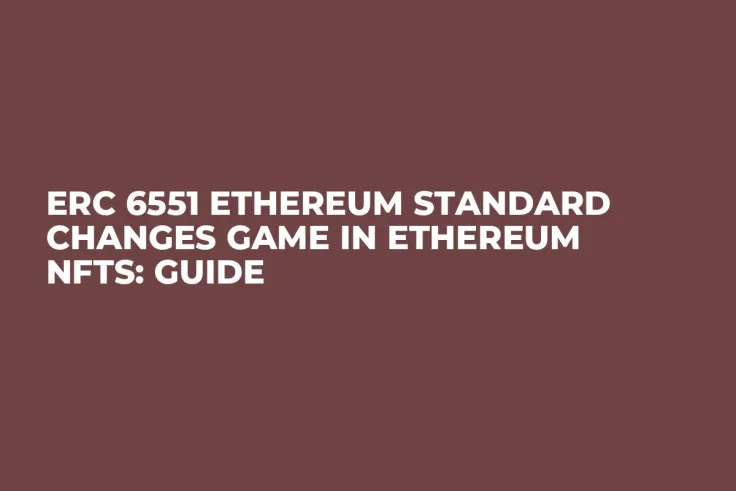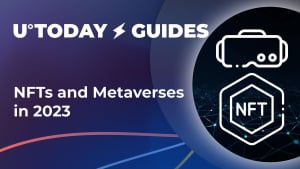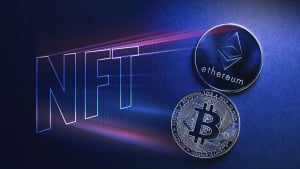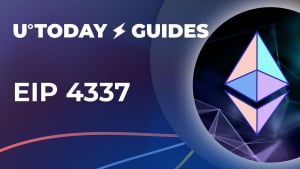
The launch of ERC 6551 or Token Bound Accounts (TBAs) is arguably the most impressive addition to Ethereum's (ETH) open-source stack in the segment of NFTs since the onset of ERC-721, a mainstream digital collectible standard.
Once it reaches massive adoption, it can change the narrative in the usage, economics and functionality of NFTs on Ethereum (ETH) and EVM ecosystem blockchains.
ERC 6551 or Token Bound Accounts: Highlights
ERC 6551, dubbed "Non-fungible Token Bound Accounts. An interface and registry for smart contract accounts owned by ERC 721 tokens," was launched on May 7, 2023.
- ERC 6551 is a standard of Ethereum (ETH) non-fungible tokens that can act as noncustodial wallets of Ethereum (ETH) accounts;
- ERC 6551 allows every ERC 721 token to achieve all the functionalities of a cryptocurrency wallet: sending/receiving transactions, storing its own NFTs, participating in airdrops and so on;
- ERC 6551 standard is backward-compatible: it can equip every existing non-fungible token with advanced functionality;
- New standard is authored by CryptoKitties co-creator Jayden Windle and Benny Giang of Future Primitive;
- ERC 6551-enabled NFTs can be used in decentralized gaming, reputation management, on-chain messaging, analytics, trading and so on.
From the very beginning, the standard has been developed in an open-source manner. However, its authors stressed that some Web3 companies are already working on instruments designed to make the "upgrading" of NFTs easier.
What are NFTs?
Non-fungible tokens, or NFTs, represent the type of cryptocurrency token with some unique features. While basically all cryptocurrency tokens (just like fiat currencies) are fungible — e.g. you can always replace 1 USDT with 1 USDT, 1 BTC with 1 BTC — every NFT is a unique token.
Under the hood, NFTs should be considered as contracts regarding ownership of some content. Should we check out the code of the majority of NFTs, we can find that they are tokenized agreements: "This is to certify that Ethereum account 0xabcd…owns the file Azuki4771.jpg starting from the block 123456." As such, most NFTs can be interpreted as tokenized digital property rights.
Users typically mint NFTs associated with digital content: images, texts, songs, videos, characters and in-game assets.
What is ERC 721?
Ethereum Request for Comments 721, or ERC 721, is a standard on the Ethereum blockchain, i.e., the standardized design of non-fungible tokens. Introduced in December 2017, this format paved the way for standard NFTs: developers are able to launch them in a streamlined manner.
On the other hand, ERC 721 is a sample of a smart contract, i.e., a code template that describes basic NFT functionality. All mainstream NFT collections — Bored Ape Yacht Club, Azuki, RTFKT — include ERC 721 tokens. Also, it is a backbone element of the tooling of all of the top NFT marketplaces: OpenSea, LooksRare, Rarible, Blur and so on.
How to create NFTs?
Basically, there are two ways to create non-fungible tokens yourself. First, you can try using no-code instruments like Mintable. With them, users can just upload their content, pay gas fees and get their NFTs minted. On some L2 chains, NFTs can even be minted in a gasless manner.
Then, NFTs can be created with OpenZeppelin code templates. To create a token this way, the user needs to set up a MetaMask wallet, pay fees (or claim testnet tokens from the faucet), take the ERC 721 code template, compile it and deploy it to the network — either Ethereum or Polygon.
What are Ordinals Bitcoin NFTs?
While, typically, NFTs are associated with programmable blockchains (that support smart contracts), in 2023, the hype around "Bitcoin NFTs" — also known as "Inscriptions" or "Ordinals" — gained steam.
Ordinals is a technology that allows attaching data to Bitcoin (BTC) transactions. As satoshis in Bitcoin (BTC) can be modified, users can equip them with content, from .jpeg files to JSON data.
However, this standard cannot go mainstream as it is technically sophisticated: to create Ordinals, you need to run a full Bitcoin (BTC) node. Also, the activity of Ordinals creators made the Bitcoin (BTC) network almost unusable.
What is Account Abstraction?
Account Abstraction, or ERC 4337, is a technology that allows Ethereum (ETH) wallets to act like decentralized banks. It blurs the line between wallets and smart contracts and paves the way for a new type of entity in Ethereum and EVM compatible blockchains, i.e., "smart wallets."
Account Abstraction was introduced in early 2023 and is usually described as the "next big thing" in Ethereum (ETH) functionality.
Vitalik Buterin described this concept as one of the three pillars of Ethereum's (ETH) progress in its transition toward a mature tech stack.
ERC 6551 or Token Bound Accounts: First comprehensive guide
ERC 6551 is a novel mechanism in the Ethereum (ETH) segment. It allows NFTs to be equipped with an additional layer of wallet functionality.
ERC 6551: Basics
ERC 6551 is a protocol that makes "regular" NFTs on Ethereum (ETH) and other EVM blockchains act like "smart contract wallets," i.e., to perform all actions that are normal for noncustodial crypto wallets. That said, it allows ERC 721 NFTs to receive and send transactions, to store their own NFTs, to swap ERC 20 tokens and so on. ERC 6551-enabled tokens are called "token-bound accounts," or TBAs.
ERC 6551 was proposed in early 2023 by Ethereum (ETH) veterans Benny Giang, co-author of ERC 721 standard and co-creator of CryptoKitties, and Jayden Windle, lead software developer at Future Primitive. In February 2023, it was published as an EIP on Ethereum Foundation forum while, on May 7, 2023, it was activated in mainnet.
The standard is fully open source and is subject to active discussion in the Ethereum (ETH) community. ERC 6551 is backward compatible; every existing NFT can be turned into TBA. Support for ERC 6551-enabled tokens has already been researched by OpenSea and a number of other blue-chip NFT institutions.
ERC 6551: Tech design
Technically, ERC 6551 is an adjustment to ERC 721, the most common standard for Ethereum's NFTs. "Regular" ERC 721/ERC 1155 NFTs contain just three types of entries, including the address of the NFT owner, the address of the person who can transfer the NFT and the characteristics of the associated metadata (content).
Image by Ethereum Foundation
As such, the functions of NFTs are limited: they only can be transferred among Ethereum (ETH) addresses. However, should we use "registries" and "proxies" (other types of smart contracts), we can map a certain NFT to a standard Ethereum smart contract address (say, BAYC 1234 to 0xabcd..).
NFT researcher and contributor to ERC721A standard 0xCygaar highlights that ERC 6551-enabled NFTs can control an unlimited number of crypto wallets:
A single NFT may control more than one contract account, however, each contract account only belongs to a single NFT.
Once this mapping happens, NFT-bound wallets become smart contracts. Not unlike multi-sigs, the owner of a smart contract can authorize a transaction by the executeCall command on the wallet.
ERC 6551: Possible implementations
As ERC 6551 NFTs become regular crypto wallets — but without losing their NFT-specific features — they have a lot of use cases in Web3 and classic economics.
For instance, thanks to impressive composability opportunities, all NFTs can be mapped to a single ERC 6551 NFT with his avatar. In a similar manner, a Web3 gamer can collect his/her in-game assets to streamline their display and usage. The entire procedure becomes user friendly and transparent. Everyone is able to track the true history of this or that NFT, which removes the possibility for cheating and selling stolen NFTs.
Then, ERC 6551 NFTs can interact with DeFis, trading bots and marketplaces without revealing the identity and core wallet of their holders. This significantly increases the anonymity and security of the NFT experience.
Even more impressive opportunities are unlocked in the "real-world" economic context. For instance, here's how NFTs of new standards can be used in the tourism segment to create a holistic travel experience.
Travel experiences thanks to NFT technology pic.twitter.com/q3R9hYM18Z
— Andrei (@andreiponi) May 31, 2023
Here's how ERC 6551 tokens can be used even by customers with no previous cryptocurrency experience.
ERC 6551: How can you benefit?
As an average user of cryptocurrency, you can benefit from starting to work with ERC 6551 tokens in multiple ways:
- For gamers: With the new standard, you can create a collection of your in-game assets and map it to a single NFT somehow associated with your profile (with an avatar, personal name and so on); this will make your reputation and status more visible;
- For NFT collectors: With ERC 6551, you can apply the "don't trust, verify" rule to your experience with buying NFTs as you can see the history of their ownership. Also, you can map your entire collection to a single NFT and exhibit it as such;
- For metaverse enthusiasts: With ERC 6551, you are able to equip your character in this or that metaverse with a more advanced toolkit of "personal" features.
As such, the activation of ERC 6551 paves the way for more immersive, transparent and feature-rich experiences in plenty of Web3 segments for new and existing NFT enthusiasts. It can actually do for NFTs what ERC 4337 or Account Abstraction does for Ethereum (ETH) as a whole.
Wrapping up
ERC 6551 is an impressive innovation in the Ethereum (ETH) segment. It enriches the tooling of non-fungible tokens with the functions of a regular crypto wallet. Everyone can turn his/her NFTs into "Token Bound Accounts" via a newbie-friendly dashboard.
With ERC 6551, NFTs become as functional as "smart crypto wallets," a new form of cryptocurrency wallet unlocked by the Account Abstraction mechanism. Starting from 2023, the line between NFTs, crypto wallets and smart contracts is blurred.



 Gamza Khanzadaev
Gamza Khanzadaev Arman Shirinyan
Arman Shirinyan Tomiwabold Olajide
Tomiwabold Olajide Alex Dovbnya
Alex Dovbnya